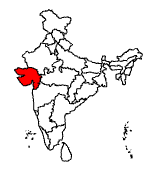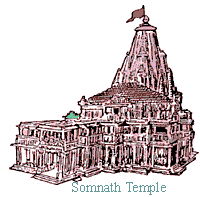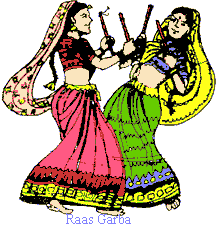
Dimdima
Online Children's Magazine from India

Dimdima
Online Children's Magazine from India
Area : 196,024 sq.km.
Population : 5,05,96,992.
Language : Gujarati.
Capital : Gandhinagar, a planned administrative city on the banks of the Sabarmati.
Location :
West coast of India. It has a boundary with Pakistan in the northwest and is surrounded by the states of Rajasthan, Madhya Pradesh and Maharashtra. Gujarat gets its name from a tribe called Gujjars which settled in the area in the 1st century A.D.
It is a maritime state with the longest coastline in the country and 40 ports, of which Kandla, a natural well-protected harbour has a Free Trade Zone, the first in the country.
The largest salt works in Asia is located near Kandla. Alang, a town on the Gulf of Kambat has the world's largest ship-breaking yard.
Gujarat ranks first in the production of cotton, groundnut, salt and milk in India.
It ranks second in the production of tobacco and third in pharmaceuticals.
Gujarat also boasts the country's largest petro-chemical complex in the country.
Other Important cities :
Ahmedabad, built by Ahmed Shah in 1411, is a major industrial centre.
Surat, on the Tapti is the cleanest city in the country and an important commercial centre.
Porbander, the birthplace of Mahatma Gandhi lies along the coastal road to Somnath. It is famous for its limestone quarries.
Vadodara (Baroda), the former capital of the Gaekwars, has impressive palaces.
Gujarat has 4 national parks and 11 sanctuaries including the Gir Sanctuary, the last habitat of the Asiatic lion.
Gujarat gets its name from the people called Gurjars but nobody is sure about where the Gurjars came from.
Some historians say they were foreigners who came with the Central Asian invaders called Huns; others say they were a hill tribe of Rajasthan that grew in power after the Huns had destroyed or dispersed the ruling class. Whatever be their origin the Gurjars rose to prominence in the sixth century A.D. They took advantage of the downfall of the once mighty Gupta empire to establish principalities in Punjab, Marwar and Broach and by the eight century the Gurjara - Pratiharas as they are referred to were an important power in the region. By the end of the 9th century they were in decline and were succeeded by the Solankis, also known as the Chalukyas. This was Gujarat's golden age and the period when its borders reached their greatest extent.
Gujarat's position on the western coast facilitated trade with the Arabs and others and was one of the factors that contributed to its prosperity down the ages. But its wealth drew to it invaders like Mahmud of Ghazni who sacked Somnath in 1025 A.D. Others followed him and in 1297 Gujarat passed into the hands of Sultan Alauddin Khilji of Delhi. A long period of Muslim rule followed. Ahmad Shah, the first independent ruler of Gujarat founded Ahmedabad in 1411.
The Mughal emperor Akbar captured Gujarat in the 1570's. Almost 200 years later in the mid-1700's it was overrun by the Marathas.
Then came the British. It was in Surat in 1612 that the British first set up their base and later went on to establish an empire in the country.
The present-day boundaries of Gujarat were drawn in 1960 when Gujarati-speaking areas of the vast Bombay state were separated from it and together with the former princely states of Saurashtra were constituted into a new state.
Gujarat is a land steeped in tradition, where festivals abound.
Ahmedabad hosts an international kite festival on Makar Sankranti on 14 January, each year.
A three-day extravaganza takes place towards the end of August every year at Tarnetar, 176 km from Ahmedabad. According to tradition, it was here that the brave Arjuna won the hand of the fair Draupadi.
The most-eagerly awaited festival is Navratri — nine nights of festivity when the entire state resounds with the beat of the dhol, cymbals, flute and the thrilling wail of the shehnai. Every street and village square comes alive with men and women, young and old, dancing the raas garba from late night to the wee hours of the morning.
Gujarat’s famous places include the 863 Jain temples of Palitana, where no one, not even the priests are allowed to spend the night; the 600-metre high Mount Girnar, where one can see a massive rock, on which the great emperor, Ashoka engraved 14 edicts in the Pali script in around 250 B.C.; Porbandar, the birthplace of Mahatma Gandhi, and the excavated sites of Lothal and Dholavira, where the ancient civilisations of Mohenjodaro and Harappa flourished.
Gujarat is also home to endangered animal species like the Asiatic lion, the wild ass and the blackbuck.



Dimdima is the Sanskrit word for ‘drumbeat’. In olden days, victory in battle was heralded by the beat of drums or any important news to be conveyed to the people used to be accompanied with drumbeats.
Bharatiya Vidya Bhavan
K. M Munshi Marg,
Chowpatty, Mumbai - 400 007
email : editor@dimdima.com
Bharatiya Vidya Bhavan
505, Sane Guruji Marg,
Tardeo, Mumbai - 400 034
email : promo@dimdima.com
Dimdima.com, the Children's Website of Bharatiya Vidya Bhavan launched in 2000 and came out with a Printed version of Dimdima Magazine in 2004. At present the Printed Version have more than 35,000 subscribers from India and Abroad.